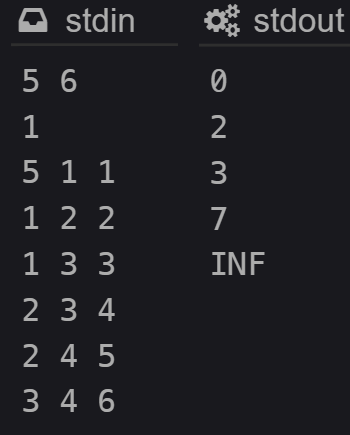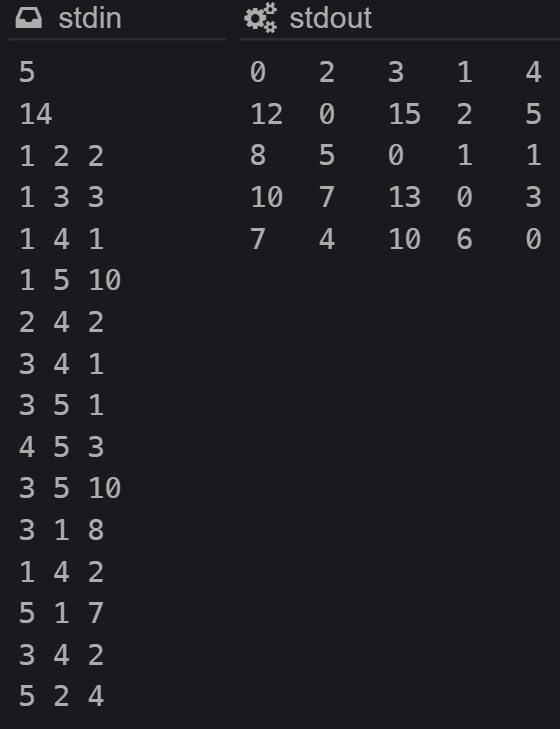
<모든 코드는 C++를 기반으로 작성되었습니다.>
Chapter 9 :: 최단 경로
예제 1. 다익스트라 알고리즘 구현
- 다익스트라 알고리즘은 임의의 기준 정점으로부터 모든 정점까지의 최단 경로를 빠르게 찾는 방법이다.
- 다익스트라 알고리즘의 시간 복잡도는 간선 개수
E, 정점 개수V일 때,
이다. - 코딩 테스트를 준비하는 사람이라면, 다익스트라 알고리즘은 자다가 일어나서 구현할 수 있을 정도로 굉장히 숙달되어야 한다.
- 동빈나씨의 github에서 제공되는 원본 C++ 코드와 굉장히 비슷하지만 다른 구석이 있다면,
min heap의 구현 과정이 조금 다른 점이다.priority_queue<p, vector<p>, greater<p>> pq로 구현한 점을 잘 알아두자.
// 다익스트라 알고리즘
#include <iostream>
#include <vector>
#include <queue>
#include <algorithm>
using namespace std;
static int N, M, startVertex, dist[100001];
static vector<pair<int, int>> graph[100001];
void dijkstra() {
priority_queue<pair<int, int>, vector<pair<int, int>>, greater<pair<int, int>>> pq;
pq.push({0, startVertex});
dist[startVertex] = 0;
while(!q.empty()) {
int curVertex = q.front().second, curDist = q.front().first;
q.pop();
if (dist[curVertex] <= curDist) continue;
for (int i = 0; i < graph[curVertex].size(); ++i) {
int nextVertex = graph[curVertex][i].first;
int nextDist = curDist + graph[curVertex][i].second;
if (dist[nextVertex] > nextDist) {
dist[nextVertex] = nextDist;
pq.push({nextDist, nextVertex});
}
}
}
}
int main() {
ios::sync_with_stdio(false); cin.tie(nullptr); cout.tie(nullptr);
cin >> N >> M >> startVertex;
for (int i = 0; i < M; ++i) {
int sv, ev, weight; cin >> sv >> ev >> weight;
graph[sv].push_back({ev, weight});
}
fill(dist, dist + N, 1e9);
dijkstra();
for (int i = 1; i <= N; ++i)
(dist[i] == 1e9) ? (cout << "INF\n") : (cout << dist[i] << '\n');
}
예제 2. 플로이드 알고리즘 구현
- 플로이드 알고리즘은 모든 기준 정점으로부터 모든 정점까지의 최단 경로를 빠르게 찾는 방법이다.
- 플로이드 알고리즘의 시간 복잡도는 이다.
- 코딩 테스트를 준비하는 사람이라면, 플로이드 알고리즘 또한 자다가 일어나서 구현할 수 있을 정도로 굉장히 숙달되어야 한다.
// 플로이드-워셜 알고리즘
#include <iostream>
using namespace std;
static constexpr int MAX = 1e9;
static int N, M, graph[501][501];
int main() {
ios::sync_with_stdio(false); cin.tie(nullptr); cout.tie(nullptr);
cin >> N >> M; // N: 노드개수, M: 간선개수
for (int i = 0; i < 501; ++i) {
fill(graph[i], graph[i] + 501, MAX);
graph[i][i] = 0;
}
for (int i = 1; i <= M; ++i) {
int s, f, w; cin >> s >> f >> w;
// 굳이 갱신할 필요가 없는 경우, 갱신하지 않는다.
if (graph[s][f] != MAX && graph[s][f] < w) continue;
graph[s][f] = w;
}
// 플로이드-워셜 알고리즘 O(n^3)
for (int k = 1; k <= N; ++k) // k번째 노드에 대해 테이블 갱신
for (int s = 1; s <= N; ++s) // 모든 출발 정점에 대해 반복
for (int f = 1; f <= N; ++f) // 모든 도착 정점에 대해 반복
graph[s][f] = min(graph[s][f], graph[s][k] + graph[k][f]);
// 수행 결과를 출력
for (int s = 1; s <= N; ++s) {
for (int f = 1; f <= N; ++f) {
if (graph[s][f] == MAX) cout << "INF" << ' ';
else cout << graph[s][f] << ' ';
}
cout <<'\n';
}
}
예제 3. 미래 도시
- 교재에서는 플루이드 알고리즘으로 풀이했지만, 다익스트라 알고리즘으로 풀 수 있다.
- 1번 도시부터 K번 도시까지 다익스트라 1번, K번 도시부터 X번 도시까지 다익스트라 1번을 사용하면, 플루이드 알고리즘을 사용한 풀이보다 빠르게 풀 수 있다.
// 미래도시
#include <iostream>
#include <vector>
#include <queue>
using namespace std;
int N, M, X, K, shortestPathList[101];
vector<int> graph[101];
int dijkstra(int startV, int targetV) {
priority_queue<pair<int, int>, vector<pair<int, int>>, greater<pair<int, int>>> pq; // Min Heap 구현
pq.push({0, startV});
fill(shortestPathList, shortestPathList + 101, 1e9); // 최소 간선 길이 테이블 초기화.
shortestPathList[startV] = 0;
// 다익스트라 알고리즘
while (!pq.empty()) {
int dist = pq.top().first, curV = pq.top().second; pq.pop();
if (shortestPathList[curV] < dist) continue;
for (int i = 0; i < graph[curV].size(); ++i) {
int newDist = dist + 1, nextV = graph[curV][i];
if (shortestPathList[nextV] > newDist) {
shortestPathList[nextV] = newDist;
pq.push({newDist, nextV});
}
}
}
return shortestPathList[targetV];
}
int main() {
ios::sync_with_stdio(false); cin.tie(nullptr); cout.tie(nullptr);
cin >> N >> M; // N: 회사개수, M: 도로개수
for (int i = 1; i <= M; ++i) {
int s, f; cin >> s >> f;
graph[s].push_back(f);
graph[f].push_back(s);
}
cin >> X >> K; // X: 도착지점, K: 소개팅지점
int ans = dijkstra(1, K) + dijkstra(K, X);
if (ans >= 1e9) cout << -1 << '\n';
else cout << ans << '\n';
}예제 4. 전보
// 전보
#include <iostream>
#include <vector>
#include <queue>
using namespace std;
int N, M, C, shortestPathList[30001];
vector<pair<int, int>> graph[30001];
void dijkstra() {
priority_queue<pair<int, int>, vector<pair<int, int>>, greater<pair<int, int>>> pq; // Min Heap 구현
pq.push({0, C});
fill(shortestPathList, shortestPathList + 101, 1e9); // 최소 간선 길이 테이블 초기화.
shortestPathList[C] = 0;
// 다익스트라 알고리즘
while (!pq.empty()) {
int dist = pq.top().first, curV = pq.top().second; pq.pop();
if (shortestPathList[curV] < dist) continue;
for (int i = 0; i < graph[curV].size(); ++i) {
int newDist = dist + graph[curV][i].second, nextV = graph[curV][i].first;
if (shortestPathList[nextV] > newDist) {
shortestPathList[nextV] = newDist;
pq.push({newDist, nextV});
}
}
}
}
int main() {
ios::sync_with_stdio(false); cin.tie(nullptr); cout.tie(nullptr);
cin >> N >> M >> C; // N: 도시개수, M: 통로개수, C: 응급도시
for (int i = 1; i <= M; ++i) {
int s, f, w; cin >> s >> f >> w;
graph[s].push_back({f, w});
}
dijkstra();
int cntCity = -1, cntTime = 0;
for (int i = 1; i <= N; ++i)
if (shortestPathList[i] != 1e9) {
cntTime = max(cntTime, shortestPathList[i]);
cntCity++;
}
cout << cntCity << ' ' << cntTime << '\n';
}- 이 문제 역시 응급도시로부터의 최단거리를 구하면 되는 다익스트라 문제다.
- 답을 구할 때 응급도시 자신이 포함되므로 -1부터 시작했다.
